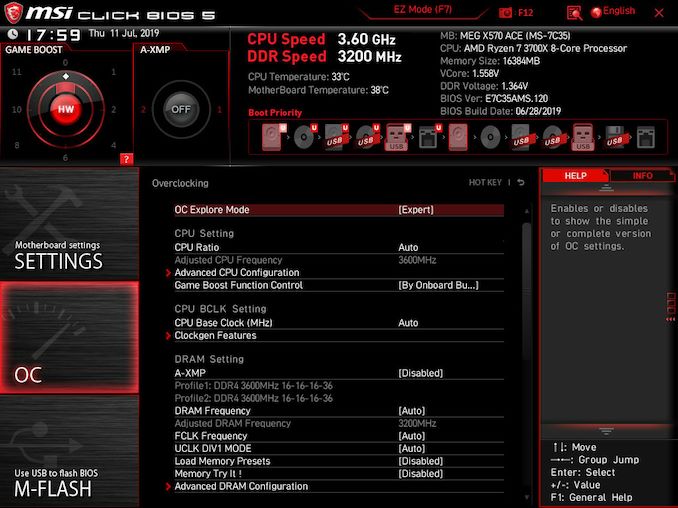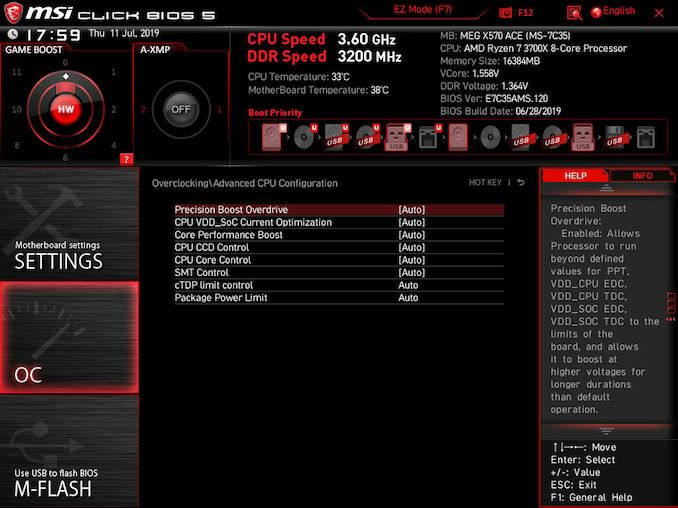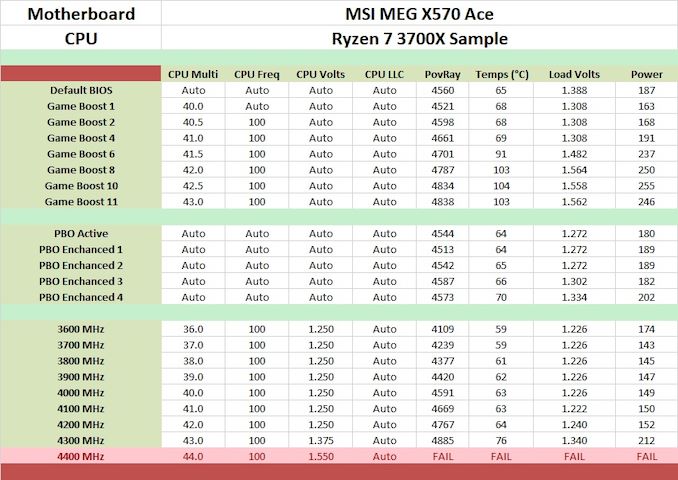The MSI MEG X570 Ace Motherboard Review: Ace in the Hole at $369
by Gavin Bonshor on July 18, 2019 11:00 AM EST- Posted in
- Motherboards
- AMD
- MSI
- AM4
- Zen 2
- Ryzen 3000
- X570
- MEG
- X570 Ace
- 3700X
- Ryzen 3700X
Overclocking Ryzen 3000
Experience with the MSI MEG X570 Ace
It's no secret that the general consensus of overclocking with the Ryzen 3000 series has been so far disappointing. Whether it be the limitations of the new 7 nm silicon or the insane temperatures that these processors run at when overclocked, or even at stock settings with the stock cooler, to unlock the full potential of these chips, better cooling methods such as premium AIOs and custom water cooling is needed.
Overclocking with the MSI MEG X570 Ace motherboard, there are three ways this can be achieved; within the firmware, with the simple, albeit effective tools inside the MSI Dragon Center application or with the comprehensive AMD Ryzen Master overclocking software. For the purpose of this review, we used the MSI Click BIOS 5 firmware which is very intuitive to use, and although this model was quite laggy, it still worked without issues. While the most commonly changed settings to overclock the processor include the CPU ratio which increases the frequency in increments of 100 MHz and the CPU VCore which increases the voltage pumped into the processor which not only generates extra heat but also increases power consumption.
In addition to the boost feature of the Ryzen 3000 processors, another AMD specific feature is called Precision Boost Overdrive or PBO. The three main variables that PBO works from including package power tracking (PPT), thermal design current (TDC), and the electrical design current (EDC). All three of these can be set within the firmware under the advanced section of the Precision Boost Overdrive menu, although MSI has included four different PBO profiles for users to select from. In addition to these are seven different Game Boost CPU overclocking profiles with each profile ranging from 4.0 GHz all cores up to 4.3 GHz all cores; these go up in increments of 50 MHz.
Overclocking Methodology
Our standard overclocking methodology is as follows. We select the automatic overclock options and test for stability with POV-Ray and OCCT to simulate high-end workloads. These stability tests aim to catch any immediate causes for memory or CPU errors.
For manual overclocks, based on the information gathered from the previous testing, starts off at a nominal voltage and CPU multiplier, and the multiplier is increased until the stability tests are failed. The CPU voltage is increased gradually until the stability tests are passed, and the process repeated until the motherboard reduces the multiplier automatically (due to safety protocol) or the CPU temperature reaches a stupidly high level (105ºC+). Our test bed is not in a case, which should push overclocks higher with fresher (cooler) air.
Overclocking Results
The 12+2 power delivery of the MSI MEG X570 Ace is one of the best we have seen from MSI in recent years and as a result, allowed us to manually overclock our Ryzen 7 3700X sample to 4.3 GHz with a set voltage of 1.375 V. Using the default load line calibration setting, this resulted in a load CPU VCore of 1.340 V which gives us a VDroop of 0.035 V in total. Of course, this can be alleviated by using a more aggressive LLC profile, but for the purposes of our testing, we leave this setting at auto. More voltage pumped into the CPU not only results in higher operating temperatures, but this also increases the overall power consumption.
Testing out each of MSI's seven Game Boost profiles did yield some interesting findings. First of all, each profile overvolted our Ryzen 3700X by a massive margin when you factor in what we achieved by using manual settings. Secondly, the three highest Game Boost profiles pumped insane amounts of CPU VCore in which in turn, made our 240mm AIO closed-loop cooler go into overdrive with temperatures in the triple digits. Outside of extreme overclocking, no Ryzen 3000 processor should be subjected to voltages of 1.562 V for a 4.3 GHz overclock on ambient cooling. Performance however was consistently higher with each of the profiles in our POV-Ray benchmark and by default with the Game Boost profiles, thermal throttling is disabled meaning that there is a trade-off between heat and performance. We also tested with PBO and found that performance was actually worse than the default settings, with MSI's four PBO profiles not really having much of an effect on performance; this leads us to believe for the most part, that PBO on Ryzen 3000 could do with a rework to make it more effective.













92 Comments
View All Comments
Peter2k - Thursday, July 18, 2019 - link
FirstOne could connect the board with the front USB ports of the case
It's rare to find a case that has no frontal USB
If you're attaching some new usb thingy more permanently to the back, you could turn the case a little or something
Second
Its clear comes button is next to the wifi cable
The layout should make it clear you're not next to USB at all
Third
Those buttons are not sticking out of the I/O cover, and an USB plug is too wide to accidentally be pushed into them
Lastly, I'm not aware of any complaints from users about such buttons
It's not a new or unique feature at all
Peter2k - Thursday, July 18, 2019 - link
BtwYou could also save your current settings and even if you do wipe them by accident, you can load them again
DanNeely - Thursday, July 18, 2019 - link
Anything semi-permanently attached gets plugged in the rear to keep the cabling mess out of the way. Front ports are for thumb drives and the like.If the system's awkwardly placed such that I can't see it, I'm probably looking for ports by touch and the buttons are finger sized. A year after the last time I've seen the back I have no idea how the ports are arranged, and am generally starting from the top and working my way down, top ports are easier to access from above so I normally fill the bottom ones first and leave the top USB open for later. The cable plug isn't going back until I've found the right location. Starting by scraping a plug around until you find something big enough for it to fit into is a good way to end up with a USB plug stuck in the second ethernet socket by accident.
Mr Perfect - Thursday, July 18, 2019 - link
No, it's not just you. My mobotherboard has a rear panel BIOS reset and I've only pressed it twice in five years. Both times where accidental.I probably shouldn't admit to that...
FreckledTrout - Thursday, July 18, 2019 - link
Yeah. I always wished they would put some type of flip cover on these so you don't mess up and hit them by accident.12345 - Friday, July 19, 2019 - link
Just save a profile to local storage.peevee - Friday, July 19, 2019 - link
Way too expensive. For comparison, for that price you can buy a basic laptop with a motherboard and WiFi, but also:1) CPU with iGPU
2) Memory
3) Display
4) Battery
5) Disk
6) Case
7) Charger
Oh the times when I could buy a microATX MB for $50 and spend money on what actually matters...
HighTech4US - Sunday, July 21, 2019 - link
Agree way too expensive.I just purchased a ASRock B450M PRO4 Micro ATX AMD Motherboard for only $74.99 from NewEgg and an AMD Ryzen 5 3600 for $199.99 and Team T-Force Vulcan 8GB (2 x 4GB) 3200 (PC4 25600) for $39.99. Total $314.97
So I got an entire CPU/Motherboard/Memory for less than this motherboard alone.
regsEx - Thursday, August 1, 2019 - link
Agreed. The red price is $280, yet only if had 10 GbE controller and 20 Gbps USB 3.2 Gen 2x2 controllers. If no, the $250.Daveteauk - Thursday, April 9, 2020 - link
Dan Neely - Yes, you are the only person who thinks that - it's a great help and addition to an IO plate - REALLY helpful. If you're too clumsy, or lazy to pull your case, then you shouldn't be playing around with PCs!